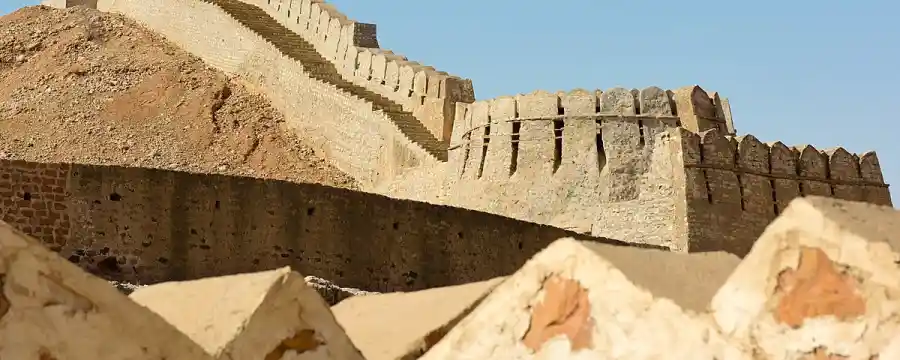Ranikot Fort - World Largest Fort

Known as the Great Indus Wall that stretches on three sides of the fort in a complex sequence of ascending and descending, through hills, valleys, and gorges. Ranikot Fort is a historical fort near San in the Jamshoro district of Sindh province. Furthermore, it is considered to be the largest fort in the world with a circumference of about 35 kilometers. Its walls are made of plaster and sandstone cut with lime. It has been included in the UNESCO World Heritage List since 1993. You will need a 4WD jeep to see all areas of Ranikot, and you can also camp overnight with a guide.
The fourth north side is protected by hills. The city walls are fortified by 45 fortresses, 7 of which are rectangular and the rest are circular. Inside the defensive walls are three forts called Mirikot, Sher Garh, and Mohan Kot, which together make up the largest fort in the world.
Additionally, the fort is located in the Kirthar Mountains, about 30 kilometers southwest of Sann city, Jamshoro District, Sindh province. There is no historical record of its construction, so no one knows who built it and for what purpose. However, the fort is constructed during the Sassanid, Scythian, Parthian, and Twin Peaks Greek regimes apparently. What exactly the fort was protecting and to whom it was a mystery. According to the Sindh gazetteer, part of the current structure was rebuilt in 1812 by Mir Karam Ali Khan Talpur and his brother Mir Murad Ali for Rs 1.2 million.
It is said to be one of the largest forts in the world. The prehistoric ruins of Amiri are located near the citadel. On a clear day, you can see the Indus 37 kilometers to the east. The fort has an area of ??about 29 square kilometers, a diameter of about 9 kilometers, and an average city wall height of 10 meters. It has four doors on four sides and is almost square. The ancient and permanent Mohan River passes through its east and west gates and contains three natural springs.
Moreover, there are three forts within Ranikot: Mirikot, Shergarh, and Mohat Kot. Mirikot is located in a very safe location in the heart of Ranikot. It is located about 5-6 miles inside the main gate, plus a small fort appears to be the royal residence of the ruling family. Some historians attribute "Mirikot" to Mirs in Sindh. There are haraam ruins, guest rooms, and military ruins. Here, you can spend a lot of time scouring different parts of the fort.
There are also some beautiful ponds and streams in the area. One of them, Parian-Jo-Thal (Fairy Pond) is deep. Many villagers bathe and enjoy the fresh water on sunny days.
What can you do here?
Tourists often here do camping, with stargazing at night. Also can do bonfire with live cooking and music session. Photographers can take astonishing photos here while exploring the Mirkot and Ranikot. Also, there is a trek to Parian-Jo-Thal which leads to a natural freshwater pond. A fully loaded trip indeed.
How to get here?
Ranikot is about 260.9 km from Karachi-Hyderabad Expressway. However, it is also easily accessible from Karachi to San on the Indus Expressway, about an hour's drive away. The detour starts at the nearest town, Sann, and follows a rough 21-kilometer (13-mile) road to the fort's east gate, the Sann Gate.
Read also:
Tharparkar
Makli Graveyard
Umerkot Fort - Sindh Pakistan
Sehwan Sharif Sindh - Pakistan
Gorakh Hill Station - Dadu, Sindh
Nagarparkar Jain Temples - Sindh Pakistan
Kot Diji Fort - A Hidden Heritage Site in Khairpur
Mir Al Bahar-Mohana Tribe - A Tribe Who spent Entire Life on Water
